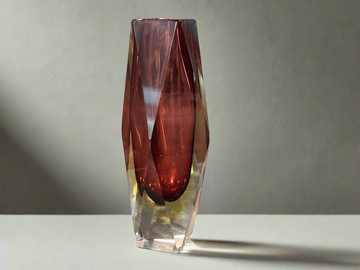Murano Sommerso Vase by Flavio Poli
A small vintage faceted Murano glass vase, in burgundy, hint of yellow and transparent glass. In excellent condition.
The photos reflect the surrounding colours too, however photo 1 closely resembles the actual colours.
The design is by Flavio Poli, and it was produced in the 60s in Italy. It is made with the Sommerso technique and has a geometric faceted block shape.
Sommerso Range
Universally regarded as one of the most prolific and capable designers of Murano glass vases and objects at large, Flavio Poli teamed up with some of the most influential and skilled glass producers of Murano to create timeless design pieces.Amongst all his works, those that gained him the most fame are without doubt the “Sommersi”, a style that was quickly imitated by other makers and is still very popular to these days. They are vases, ashtrays, paperweights characterised by the juxtaposition of vibrant colours in contrasting tones that generate a beautiful overall aspect: the original collection earned him the Golden Compass, the most important award for italian designers, in 1954.designed by Flavio Poli for Alessandro Mandruzzato (Murano, Italy, 1960s).
Key Features:
• Designer: Flavio Poli, iconic Murano glass artist
• Technique: Sommerso – layered glass for rich color depth
• Shape: Organic, sculptural curves with flowing edges
• Era: Mid-20th century, a classic of mid-century modern design
• Craftsmanship: Hand-blown by Murano artisans, making each piece unique
Why It’s Highly Collectible:
Poli’s use of bold colors and the organic form make this vase a standout example of Italian mid-century glass. The vase’s authenticity and condition, [add condition details here], enhance its value as a piece of Murano art glass history.
Add this elegant, mid-century Murano art glass vase to your collection—a rare investment in timeless Italian craftsmanship. Perfect for collectors and lovers of fine art glass.
A Brief History of Murano Glass
The cluster of islands known as Murano emerges from the Venetian lagoon, a vast expanse of water whose surface reflects every shift in light. Since the thirteenth century, glassmakers have observed these shimmering waters outside their workshops, a vision reflected in the art that has made Murano, and its glass masters, world-famous.
Glassblowers came to be located on Murano for two reasons. The first was to minimize fire risk in Venice. The great number of glass-firing ovens—which regularly reached some 1500 degrees Celsius—produced beautiful glass objects but also initiated fires in the city. The fire hazard must have become onerous because by the 1270s, city officials had begun to transfer glass workshops from the center of Venice to Murano, a process completed by 1291. The second reason to relocate glassmakers to Murano was probably political. Trade secrets of Murano glassmaking were already being leaked across Europe during the Middle Ages, and sequestering glassmakers on Murano allowed the Republic to control glass production and exportation, ensuring that these secrets remained in Venice. Glassmakers faced steep fines or even imprisonment if they traveled outside the Republic, though interestingly, glassmakers from Dalmatia, Bohemia, and elsewhere were occasionally authorized to work on Murano. Until the sixteenth century, Murano glassmakers held a monopoly on European glassmaking, and their stunning creations brought them renown across the world.
Industry Vintage is proud to offer tailored delivery options no matter where you are in New Zealand—from Cape Reinga to Bluff and everywhere in between. Wherever you are, we’ll find a way to get your order to you safely, and if you have unique shipping needs or require a personalised delivery service, just let us know—we’re only too happy to help!
Here's all you need to know about our shipping process, rates and timeframes. If you have any questions, our contact details are below. Please don't hestiatate to get in touch.
Prioritising "Feel Good" Over "Fast Furniture"
At Industry Vintage, we believe in doing things right, even if that's a little different. We take extra care to ensure your items are delivered safely and securely. While this may take a little longer than mainstream retailers, we promise it’ll be worth the wait.
Confirming Your Order
Here’s what happens after you place your order:
- We’ll confirm shipping costs and...
At Industry Vintage, we take pride in offering unique vintage treasures. Each item has its own history, and we do our best to provide accurate descriptions and photographs that highlight its condition, dimensions, and design.
If you have any questions about an item, please use the "Ask a Question" feature on the product page or contact us directly via phone or email before making your purchase.
Before Placing Your Order
Please carefully review all item details, including:
- Dimensions: Ensure the item will fit your intended space.
- Descriptions and Condition Notes: Take note of any unique features or imperfections.
- Photographs: Inspect all images to understand the item's current condition.
Important Notes:
- Many items are one-of-a-kind and cannot be replaced.
- All items are sold “as is,” retaining the character and imperfections that make them special.
- Exchanges for items of similar value are not available.
If additional information is needed, feel free to contact us prior to purchasing—we’re happy to














